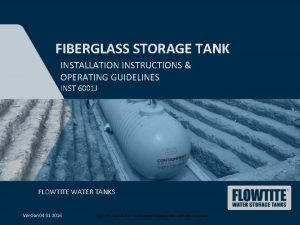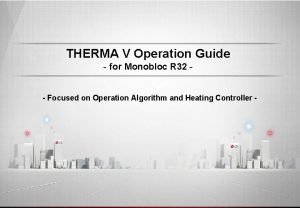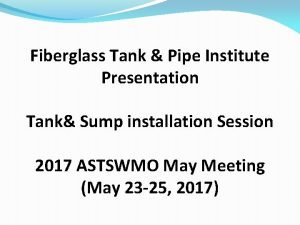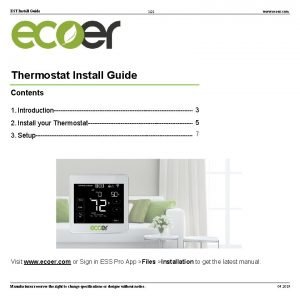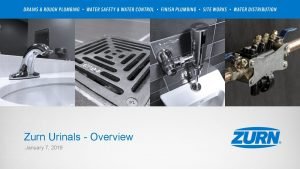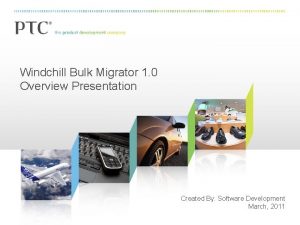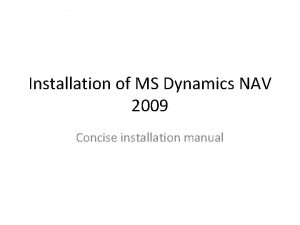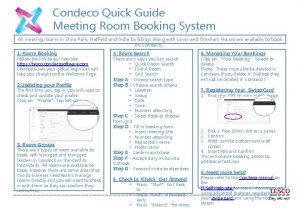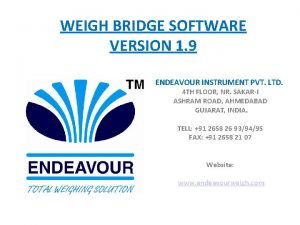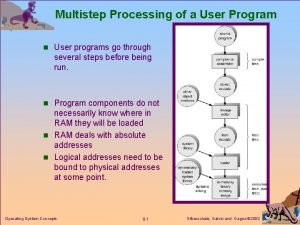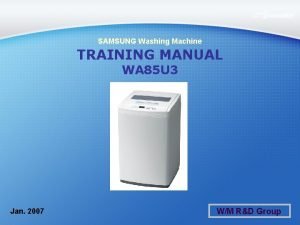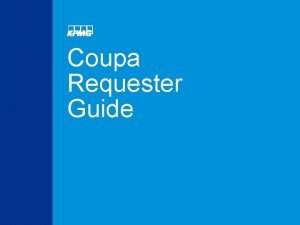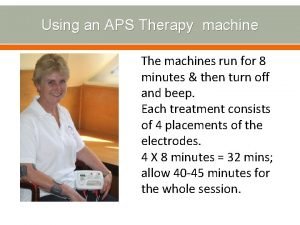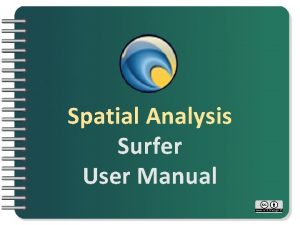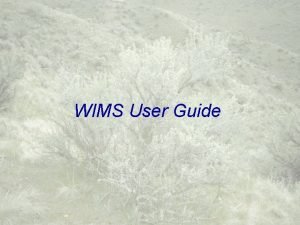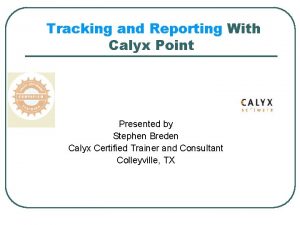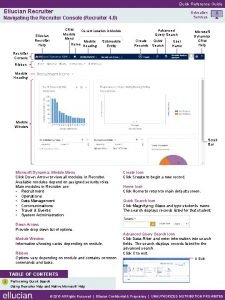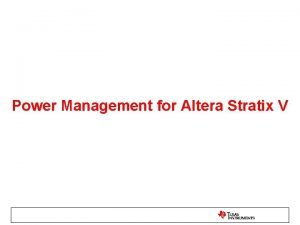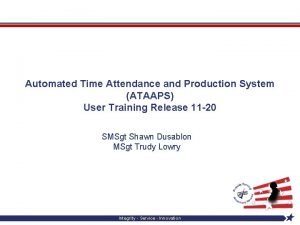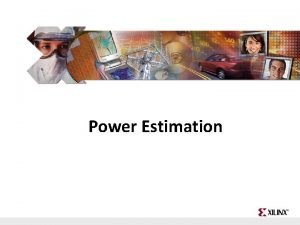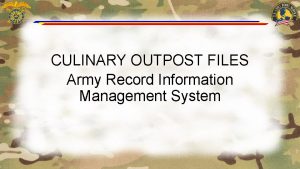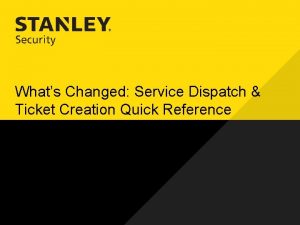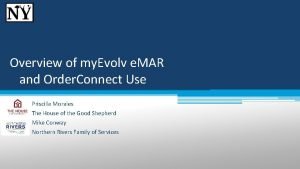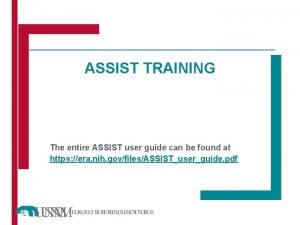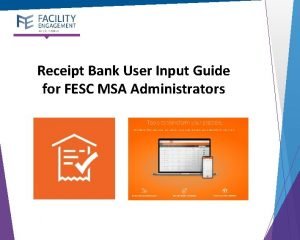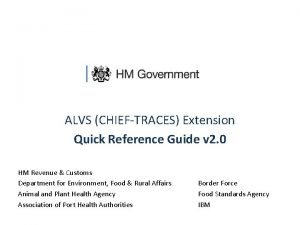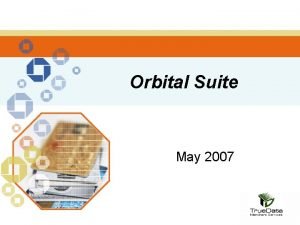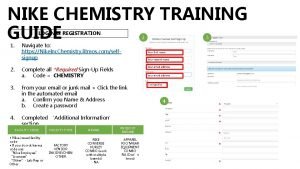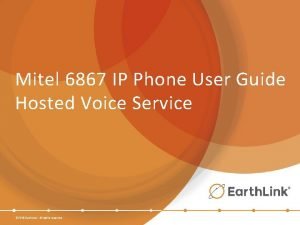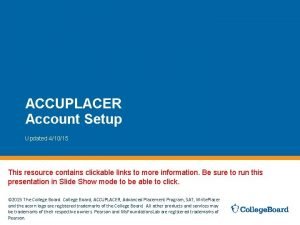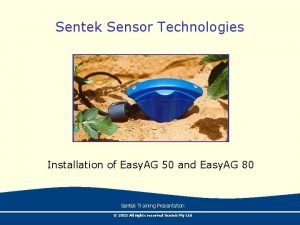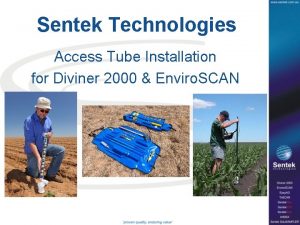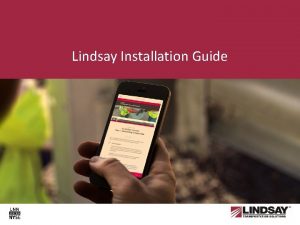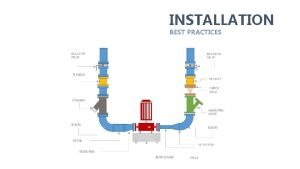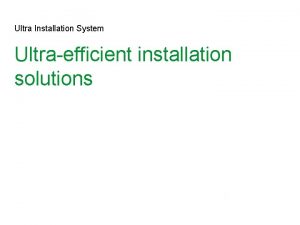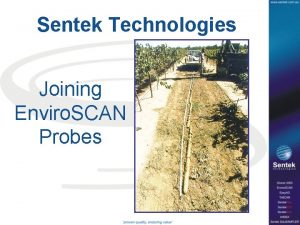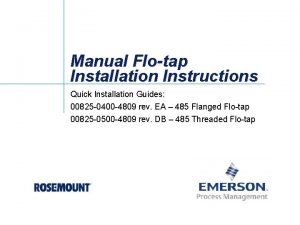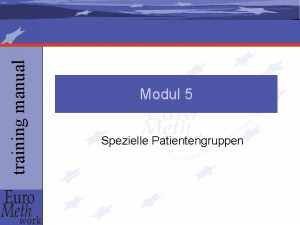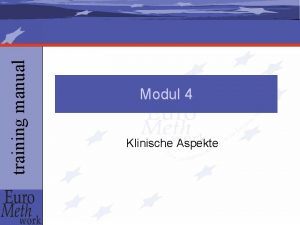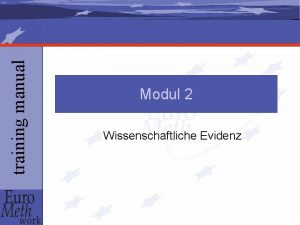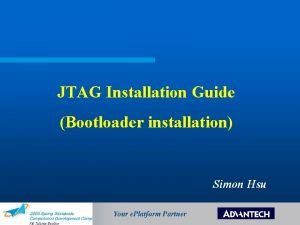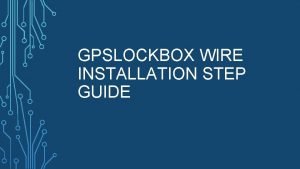Sentek MULTI Field Installation User Guide Training Manual



























































































- Slides: 91

Sentek MULTI™ Field Installation User Guide & Training Manual Version 1. 0 Copyright © 2011

This manual describes the Sentek. TM MULTI soil water monitoring system and includes technical information regarding hardware assembly and field installation. Version 1. 0 Copyright © 2011 Sentek Pty. Ltd. All rights are reserved. No part of this publication may be reproduced, translated into any language or by any means transmitted by electronic, mechanical, or other methods without prior written permission of Sentek Pty Ltd, 77 Magill Road, Stepney, South Australia 5069, Australia. The information in this document is subject to change without notice. The latest updates or modification to this manual appear as Sentek™ MULTI technical bulletins on our web-site. Sentek ™, Irri. MAX™, Enviro. SCAN ™, Tri. SCAN ™, Easy. AG ™ and Enviro. SMART ™ are trademarks of Sentek Pty Ltd, that may be registered in one or more jurisdictions. Other products and company names mentioned in this document may be trademarks of their respective owners. Copyright © 2011 Acknowledgements Sentek Pty Ltd gratefully acknowledges Trevor Sluggett and Peter Keynes of Agri. Exchange Pty. Ltd. , Renmark, SA for the kind provision of a test site venue and assistance with the installation of the Sentek MULTITM. The pictures used in this manual were taken at this venue. We further thank and acknowledge the support and assistance of staff and management personnel of Mt. Lofty House, Adelaide, SA and Doug Marks, Caurnamont Farms, SA.

Sentek Multi. TM supports 2 Sentek probes with 16 sensors on each, 2 pulse inputs (eg. rain gauges or flow meters) and 2 RTD temperature sensors. Data of all sensors is logged on the probe interfaces and are regularly uploaded to the Internet by a Data Transmission Unit (DTU). Shown below are all components excluding flow meters as shipped to the user. The Sentek probes shown are Enviro. SCAN and Flat Cap. The connection plugs may vary depending upon client requirements. Set up of the probe configurations is explained in separate manuals. Rain Gauge Enviro. SCAN™ Flat Cap Probe Rain Gauge Enviro. SCAN™ Screw Cap Probe Solar Panel Battery Temperature Sensor Copyright © 2011 Data Transmission Unit Temperature Sensor Antenna with Cable

WIRING Copyright © 2011

WIRING This is the Sentek MULTI™ Data Transmission Unit (DTU) as supplied by Sentek. The front Panel has been opened and the battery removed. Probe Connectors Sentek MULTI™ Housing DTU Main Board Copyright © 2011 Modem

WIRING Inside the Sentek MULTI™ housing, mark the probe connectors 1 and 2 with a marking pen. Probes 1 and 2 should later be connected to each respective connector. Next to the probe connector 1 you will find a cable gland for the solar panel and an open hole where the antenna cable (already fitted with cable gland) is to be installed. If temperature sensors are to be installed, mark the MULTI™ housing holes with “T 1” and “T 2” and remove the protective blind grommets. If rain gauges are to be installed, mark the MULTI™ housing holes with “R 1” and “R 2” and remove the blind grommets. Inside View of MULTI Housing Cable Gland for Solar Panel Outside View of MULTI Housing Probe Connectors Blind Grommets Open Hole for Antenna Cable with fitted Cable Gland Copyright © 2011

WIRING This is the RTD temperature sensor as supplied by Sentek. A cable gland has already been fitted. Copyright © 2011 The wires of the temperature sensor have been terminated using ferrules.

WIRING Remove the blind grommets and install the cable gland of the temperature sensor. Copyright © 2011 Ensure that the cable gland is tightened properly.

WIRING Temperature Sensor 1 is screwed into connector RTD 1 as shown. White Copyright © 2011 Red

WIRING The second temperature sensor is wired to the RTD 2 connector as shown. Copyright © 2011 The two temperature sensors have now been wired to the main board within the MULTI housing

WIRING This is the rain gauge as shipped. A cable gland has already been fitted to the rain gauge extension cable. Copyright © 2011 The end of the rain gauge wire is terminated with ferrules.

WIRING Rain gauge 2 is screwed into connector RG 2 as shown. The right-most terminal of RG 2 is left blank. Red Copyright © 2011 Green Rain gauge 1 is connected to the RG 1 connector located to the left of the RG 2 connector.

WIRING Attach the short rain gauge cable located at the bottom of the rain gauge to the wired-in rain gauge extension cable as shown. In the field this connector should be sealed with self-amalgamating tape. Copyright © 2011

The antenna is attached to the antenna cable which is fitted with a cable gland. Secure the cable gland at the position of the open hole at the bottom of the MULTI housing. Copyright © 2011 WIRING Screw the terminal connector of the antenna to the elbow connector on the modem.

WIRING The Solar Panel is not equipped with a cable gland. Feed the cable through the cable gland located at the bottom of the MULTI housing. This solar panel has a bird deterrent already fitted (available by order). Connect the wires to the solar panel connector on the main board as shown. Red Copyright © 2011 Black

WIRING Unscrew the connector cap for the probe at the bottom of the MULTI housing. Copyright © 2011 Connect the probe.

WIRING Screw the probe cable to the connector using the screw sleeve. Ensure probe 1 is attached to connector 1 and probe 2 to connector 2. At the top of the probe terminate the probe cable wires as shown. Screws 1, 4, 5 and 6 only are used. White (6) Blue (5) Green (4) Red (1) 8 Copyright © 2011 1

WIRING The battery cable is shipped plugged into the main board (indicated by the red box). Connect the battery terminals as shown. NOTE: This is done only after all other wiring has been completed. Copyright © 2011

WIRING All Wires are now connected to the Sentek MULTI™ Main Board. Rain & Irrigation Gauges Sentek Probes 1 & 2 Temperature sensors 1 & 2 Battery Antenna Solar Panel Copyright © 2011

WIRING All sensors, the battery, the solar panel and the antenna are wired up to the DTU. NOTE: Ensure that all cable glands are tightened properly at the base of the MULTI™ housing. Copyright © 2011

SOFTWARE CONFIGURATION Copyright © 2011

Normalization Individual probes need to be set up before use by accessing their circuitry interfaces. Operational ranges need to be set (normalization) as well as probe configurations, interface clocks and web settings. Connect the probes to the MULTI housing, attach the battery and turn the MULTI unit on. Use the switch to select the probe number to be normalized. Connect the Interface Configuration Cable from a laptop computer to either the MULTI front panel or. . . Copyright © 2011 . . . to the probe interface TTL connector. NOTE: The correct drivers need to be installed on your computer before using either cable.

Normalization Run the latest version of the Probe Configuration Utility program (available Sentek website). Select the correct Serial Port and Baud Rate. In the Configuration menu click on Auto-detect Sensors. You will then be looking at this screen or similar (depths, serial port, number, address and version may differ). NOTE: the first line of the version number specifies the probe interface firmware version while the second line specifies the Sentek MULTI™ board firmware version. Below this is the Probe Configuration software version number (must be at least this one). Copyright © 2011

Normalization Set the first depth using the arrow keys. Double-click on subsequent depths to increment in 10 cm automatically. Copyright © 2011

Normalization Place the probe into the access tube and suspend it in air so that nothing approaches within 14 cm of the sensors. Do not place on a surface or near any solid objects that may interfere with the sensor reading. Click on High/Air to set all Air Normalization values or set depth levels separately using the set boxes. Copyright © 2011

Normalization Place the probe into the sealed access tube into a water bath or the Normalization Container. Each sensor needs to be completely surrounded by water. Now click on Low/Water to set all Water Normalization values or set depth levels separately using the set boxes. Copyright © 2011

Calibration Verify the calibration equation parameters a, b & c. If using the standard default calibration, leave unaltered. If using a site specific calibration, type the values of the equation into this field. Click on Write To Probe. Copyright © 2011

Set Clock In the Clock menu, set the Sampling Interval to the desired value using the drop down arrow. To adjust the clock, either enter in the correct date and time, adjust using the drop down arrows or click on Synchronize with Computer. Click on Write To Probe. Copyright © 2011

Logger and Web Settings In the Plus/Solo menu, set the Logger ID. Enter a valid URL which has been set up by your IT professional. These details can also be entered using the Edit key. Click on Write To Probe. Copyright © 2011

Data Upload Frequency Set the uploading interval using the Sample Count. A suggested upload frequency is every 2 -3 hours. Increased frequency of uploads will increase data transfer usage and cost. Click on Write To Probe. Copyright © 2011

Dial-in Uptime Set the Dial-in Uptime. A suggested time is 10 minutes. This will allow the modem to remain on for 10 minutes when uploading, allowing the sending of remote commands to the DTU from a computer. This is useful for troubleshooting. NOTE: Ensure that Probe 2 reading times do not clash with times that the modem is powered on (and vice-versa) as loss of data will occur. Click on Write To Probe. Copyright © 2011

Temperature Sensor Recording In the Multi menu, click the check box(es) for the sensor(s) to be recorded. Set the depth(s) of the Temperature Sensors using the arrows or type them in. Ensure that the individual sensor wiring is connected to the correct terminal. Click on Write To Probe. Copyright © 2011

Rainfall, Irrigation and Flow Meter Recording Click the check box(es) for the sensor(s) to be recorded. Ensure that the individual rain gauge wiring is connected to the correct terminal. Set the type of sensor using the drop-down arrow. Set the pulse value from the rain gauge manufacturer specifications. Click on Write To Probe. Copyright © 2011

Network Settings Ensure that you have the correct network settings for the type of modem you are using. Select Restore Configuration followed by the “****. cfg” file which matches your modem. Network settings can be downloaded from the Sentek website. Copyright © 2011

Modem Test Modem default settings are fixed for Telstra users in Australia. For any other carrier, ensure that you have the correct modem settings for your telemetry provider. Refer to the hardware manual and provider web sites for these. Ensure that you are in an area with adequate telephone signal strength. In the Modem menu, click on Test to perform a test upload to check the ability to communicate with the server. “ 040 Success” should be returned. Copyright © 2011

Power Recording In the Power menu, click the check boxes that you wish to have data recorded from (as a minimum, Battery Voltage and Solar Charge is recommended). Click on Write To Probe. Copyright © 2011

Backup Configuration ALWAYS save a copy of the completed configuration somewhere safe on your computer. Use the logger name in the file name for easy identification later. Copyright © 2011

Check All Sensors In the Sensor Test menu, click on Query All Sensors. Check that the calibrated values returned are within sensible ranges (0 for air and 2 -55 for soil). Click on Stop Sensor Querying. Copyright © 2011

Delete Readings In the Plus/Solo menu delete the data collected during the setup process. This allows you to start with a fresh database with correctly-zoomed initial graphs. Copyright © 2011

Disconnect and Exit from the Probe Configuration software. Copyright © 2011

INSTALLATION OF DATA TRANSMISSION UNIT (DTU) Copyright © 2011

Installation of DTU At the chosen location for the DTU, auger a hole with a 53 mm diameter auger to a depth of 1 m. Copyright © 2011 Cut a 1. 3 m length of 55 mm diameter aluminium tube. This tube becomes the base support for the DTU pole. NOTE: this is a suggested pole support mechanism only. Other methods may be available. This method is shown here due to the ease of system removal during harvest or farm traffic.

Installation of DTU Screw in 2 self-tapping screws about 100 mm from the end of the aluminium tube. The bottom of the DTU pole will come to rest on these screws. Copyright © 2011 Place a metal dolly on top of the aluminium tube and drive it into the prepared hole.

Installation of DTU When installing into an orchard, the mounting pole for the DTU and solar panel should extend above the tree canopy. Here a 2. 5 m long pole is being used. Copyright © 2011 Slide the pole through the bracket of the MULTI™ housing.

Installation of DTU Slide the MULTI™ housing to the desired position and tighten the bracket screws. Copyright © 2011 To fit the bird deterrer to the solar panel, unscrew both top screws of the solar panel frame.

Installation of DTU Fit the bird deterrer to the top of the solar panel as shown. Copyright © 2011 Re-tighten the top screws of the solar panel

Installation of DTU Insert the bolts into the holes of the mounting bracket (threads pointing outward) and then slide the bolt heads into the side rails of the solar panel. Copyright © 2011 Adjust the solar panel to a 45 degree angle relative to the pole bracket and tighten the nuts.

Installation of DTU Slide the top of the pole through the solar panel bracket and tighten the bolts. Copyright © 2011 Insert the solar panel cable into protective flexible conduit.

Installation of DTU Attach the antenna mounting bracket to the solar panel mounting bracket using 2 screws and bolts. Copyright © 2011

Installation of DTU Screw the antenna base into the cable base through the fitted antenna bracket. Copyright © 2011

Installation of DTU Insert the antenna cable into protective flexible conduit and secure it to the pole using cable ties. Fit the aluminium pole end cap. Copyright © 2011

Installation of DTU Secure the protected solar panel cable to the pole with cable ties and insert it into the base support tube. Copyright © 2011

Installation of DTU To stop the MULTI™ housing and solar panel pole rotating inside the base support tube, a 5 mm diameter locking pin is installed. Drill a 6 mm hole through both tubes about 50 mm from the top of the base support tube. Copyright © 2011 Push the locking pin through all of the holes and lock it into position.

INSTALLATION OF ACCESS TUBE & PROBE Refer to “Installation of Sentek Soil Moisture Probes” Manual available from web site. Copyright © 2010

INSTALLATION OF RAIN GAUGE Copyright © 2011

Installation of Rain Gauge Using a 100 mm diameter auger, excavate a hole to about 60 cm. NOTE: this is a suggested pole support mechanism only. Other methods may be available. Copyright © 2011 The base support tube for the rain gauge pole needs to be very sturdy to avoid movement of the rain gauge and tipping bucket by wind. Shown here is a 70 cm long 105 mm steel pipe which is fitted with 8 positioning bolts. The base support tube is lowered into the hole.

Installation of Rain Gauge The base support tube of the rain gauge pole protrudes by about 50 cm. Copyright © 2011 The soil around the base support tube is compacted into place.

Installation of Rain Gauge Affix the base mounting plate of the rain gauge to the top of the square mounting pole as shown. Copyright © 2011

Installation of Rain Gauge Insert the rain gauge pole into the base support tube and loosely secure it with the tightening bolts. Copyright © 2011

Installation of Rain Gauge Use a spirit level to ensure that the pole is vertical. Copyright © 2011 Tighten the upper bolts to lock the pole into place. Ensure that the rain gauge will not be overshadowed by crop foliage.

Installation of Rain Gauge Tighten the lower bolts for added stability. Place a reflective marker sticker onto the pole to avoid Check that the pole remains vertical and adjust if necessary. damage by farm traffic. Copyright © 2011

Installation of Rain Gauge Place the rain gauge base with tipping bucket carefully over the base mounting plate. Align the 3 holes in the rain gauge base with the screws of the base plate and secure them with the nuts provided. Copyright © 2011 Use three bolts to centralize the levelling bubble at the base of the rain gauge.

Installation of Rain Gauge Feed the rain gauge extension cable into the slot at the top of pole. Copyright © 2011 Thread the cable through the hole at the bottom of the pole.

Installation of Rain Gauge Connect the rain gauge connector to the extension cable. This connector can be made water resistant using self-amalgamating tape. Copyright © 2011 Secure the connector under the base of the rain gauge.

Installation of Rain Gauge Place the rain gauge bucket onto the rain gauge base. Copyright © 2011 Secure the rain gauge bucket to the base with screws.

INSTALLATION OF RAIN GAUGE FOR IRRIGATION MEASUREMENTS Copyright © 2011

Installation of “Irrigation Gauge” If the rain gauge is used as an “irrigation gauge” the mounting plate needs to be fixed to a concrete block. A Hebel™ block is shown here. Level the block using a spirit level. Drip irrigation is being used here. Copyright © 2011 Secure the mounting plate to the Hebel™ block with nuts and bolts.

Installation of “Irrigation Gauge” Position the nuts of the mounting plate about 3 cm above the base. Copyright © 2011 Align the “irrigation gauge” base screw holes with the mounting plate bolts. Slide the base over the bolts and secure with nuts.

Installation of “Irrigation Gauge” Adjust the level of the “irrigation gauge” base, so that the bubble is in the centre of the indicator using the nuts. Copyright © 2011 Attach the “irrigation gauge” bucket with screws. Connect the cable using the plug connectors. This connection can be made water resistant using selfamalgamating tape.

Installation of “Irrigation Gauge” Attach a length of irrigation tubing to the drip outlet of a button emitter. Other arrangements are necessary for sprinkler or microspray irrigation systems. The “irrigation gauge” may need to be partially buried in these cases. Copyright © 2011 The rain gauge bucket must be covered to exclude rainfall. A bucket with a hole in its base is convenient for this.

Installation of “Irrigation Gauge” Thread the irrigation tubing through the hole in the bucket and. . . Copyright © 2011 71 . . . secure it to the rain gauge filter cylinder with a cable tie.

Installation of “Irrigation Gauge” Secure the bucket cover to the rain gauge base with a cable tie. Copyright © 2011 72 Seal the hole in the bucket cover with silicone.

Installation of “Irrigation Gauge” The completed rainfall gauge as an irrigation gauge. Copyright © 2011 73

INSTALLATION OF TEMPERATURE SENSORS Copyright © 2010

Installation of Temperature Sensors The sensor must have good contact with the soil. Locate the sensor(s) at the required depth by digging a hole, pushing the sensor(s) into the soil at the chosen depth(s) and backfilling with soil. Copyright © 2011 Temperature sensors can also be used to measure the inside canopy (air) temperature. The protective shade housing for the sensor is not shown here.

FINAL TOUCHES Copyright © 2010

Final Touches Protect cables in high traffic areas by submerging them in trenches. Copyright © 2011 Place cables into the trench and backfill it.

Final Touches At the base of the DTU and Solar Panel pole excavate a hole to accommodate a valve box. Copyright © 2011 Excess cable loops of sensors can be neatly stored within this valve box.

Final Touches Protect all exposed sensor cabling against animal attack with flexible conduit protector. Copyright © 2011 Check all cable wiring. Connect the battery and place it into the MULTI™ housing (terminals facing backwards).

Final Touches Attach the main board to the MULTI™ housing 4 screws (circled). Copyright © 2011

System Front Panel Display Check Bat – Battery Status • On – Charging • Flash (single at regular interval) – Battery good, voltage >10 V • Flash (double) – Battery low, voltage < 10 V • Off – Service mode Sol – Solar Status • On – Solar panel voltage present (>17 V) • Off – Solar panel voltage not present Warn – Warning Indicator • Flash (fast) – Entering service mode • Flash (single) – Service mode active (probes powered off) • Flash (double) – Service mode active (firmware update) • On – Board fault MDM –Modem activity • On- front panel connected and PROBE SELECT switch in modem position (centre) or modem activity Probe 1 – Probe 1 activity • On – Front panel connected and PROBE SELECT switch in P 1 position (left) or Probe 1 activity Probe 2 – Probe 2 activity • On – Front panel connected and PROBE SELECT switch in P 2 position (right) or Probe 2 activity USB – USB Status • On – USB connected (device is not suspended and enumeration by host is complete) • Off – USB not connected (or connected but suspended by host controller) OK – General Status • On/Flash - Activity Copyright © 2011 On/Off Switch • On/Flash - Activity PROBE SELECT Switch • Left position = Probe 1 • Right Position = Probe 2 • Centre Position = Modem

Final Touches Close the lid of the MULTI™ housing and secure it with the latch. A padlock may also be fitted. Copyright © 2011

™ Sentek MULTI Installed! The installation of Sentek MULTITM is now complete. Copyright © 2011

SETUP OF “IRRIGATION GAUGE” IN DRIP IN Irri. MAX™ Copyright © 2011

Correction for Drip in Irri. MAX™ • Calculating the true application rate from a drip irrigation system is difficult to do due to the non-uniformity of the wetting pattern. Hence, any calculations of the water applied are estimates only. • If a rain gauge is used to measure total irrigation application from a dripper (and excluding rain), then a calculation is required to correct for the area over which this water would normally disperse. There are various ways in which this can be done including: a) Volume calculation or b) Depth of Irrigation calculation. • Both calculations can be performed in Irri. MAX™ 9. 0 under the Properties menu during graphing using the Edit Unit of Measure check box. Copyright © 2011

a) Volume Calculation • The volume applied from the single drip line which has been redirected into the rain gauge bucket is recorded as a number of tips. • Each tip has a defined volume set by the manufacturer, so the total volume applied is given by the number of tips multiplied by the volume of each tip. • These specifications are given on the manufacturer’s Calibration Certificate. • Irrigation (L) = Uncorrected Rain Gauge Output (mm) x Tip Volume (m. L) Tip Size (mm) x 1000 Copyright © 2011

a) Volume Calculation Example • • Daily rain gauge value = 370 mm (obviously too high). Tip Size = 0. 2 mm (from Rain Gauge specifications sheet). Tip Volume = 6. 67 m. L from Calibration Certificate: 100 m. L Tip Test = 15 Tips, therefore Tip Volume (m. L) = 100 = 6. 67 m. L 15 Irrigation (L) = Uncorrected Rain Gauge Output (mm) x Tip Volume (m. L) Tip Size (mm) x 1000 Irrigation (L) = 370 x 6. 67 = 12. 34 L 0. 2 x 1000 The multiplier for the Irri. MAX™ calculation in this case is therefore: 12. 34 = 0. 033351 370 A rough check of this is to multiply the dripper flow rate (L/h) by the irrigation time (h). For example: 3 L/h dripper x 4 hours = 12 L. Copyright © 2011

b)Depth of Irrigation Calculation • • The Depth of Irrigation calculation takes into account the area that is wetted during the irrigation (so-called dispersion area). The dispersion area will depend upon the soil texture and should be determined by measuring the width of the wetting front in the field at a depth of 30 cm after an irrigation. Dig a trench near a drip emitter and determine the wetting front position relative to it (r). Multiply this value by 2 to determine the wetting diameter (d). The square of this is an approximation of the wetted area. A better estimation is to calculate the area of a circle (πr 2) but this is not shown here. If adjacent drippers overlap their wetting fronts, then this needs to be taken into account also. Refer to agronomic literature or web calculators for these corrections. Irrigation = Uncorrected Rain Gauge Output (mm) x Tip Volume (m. L) (mm) Tip Size (mm) x 1000 x Wetted Area (m 2) Copyright © 2011

b)Depth of Irrigation Calculation Example • • • Daily rain gauge value = 370 mm (obviously too high) Tip Size = 0. 2 mm (from Rain Gauge specifications sheet) Tip Volume = 6. 67 m. L from Calibration Certificate: 100 m. L Tip Test = 15 Tips, therefore Tip Volume = 100 = 6. 67 m. L 15 • Wetting front diameter = 0. 8 m (measured in field at 30 cm depth) • Wetted area = 0. 8 m x 0. 8 m = 0. 64 m 2. • Irrigation (mm) = Uncorrected Rain Gauge Output (mm) x Tip Volume (m. L) Tip Size (mm) x 1000 x Wetted Area (m 2) • Irrigation (mm) = 370 x 6. 67 = 19. 28 mm • 0. 2 x 1000 x 0. 64 • The multiplier for the Irri. MAX™ calculation in this case is: 19. 28 = 0. 052083333 370 Copyright © 2011

Setting the rain gauge corrections in Irri. MAX™ Graph the irrigation data and right-click anywhere in the pane. Select the Properties menu. Enter a Custom Unit (mm in this example). Select Edit Unit of Measure check box. Copyright © 2011

Setting the rain gauge corrections in Irri. MAX™ Enter a unit of measure. Enter a value to correct Rain Gauge Output to the desired unit (mm in this case). Refer to example from b) above. Copyright © 2011
 Sentek soil moisture
Sentek soil moisture Single user and multiple user operating system
Single user and multiple user operating system Single user and multi user operating system
Single user and multi user operating system Tru count air clutch
Tru count air clutch Tema server
Tema server Gree wifi module
Gree wifi module Containment solutions installation manual
Containment solutions installation manual Lg therma v error code ch 14
Lg therma v error code ch 14 Rf5132/rfk55xx installation manual
Rf5132/rfk55xx installation manual Fiberglass tank and pipe institute
Fiberglass tank and pipe institute Et 500 gate motor manual
Et 500 gate motor manual Ecoer heat pump installation manual
Ecoer heat pump installation manual Zurn
Zurn Windchill bulk migrator
Windchill bulk migrator Installing fusioncompute
Installing fusioncompute Microsoft dynamics nav 2009 installation guide
Microsoft dynamics nav 2009 installation guide Condeco software tesco
Condeco software tesco Opendlp
Opendlp Epnm installation guide
Epnm installation guide Pure storage installation guide
Pure storage installation guide Hp esp
Hp esp Dna center installation guide
Dna center installation guide Waiting line management system
Waiting line management system Multi loop pid controller regolatore pid multi loop
Multi loop pid controller regolatore pid multi loop Weighing bridge software
Weighing bridge software Multi step processing of a user program
Multi step processing of a user program Multi user operating system
Multi user operating system Multi user dbms architecture
Multi user dbms architecture Multi user dbms architecture
Multi user dbms architecture Multi user augmented reality
Multi user augmented reality Kpmd software solutions
Kpmd software solutions Multi-field intensifiers
Multi-field intensifiers Sailor 6018
Sailor 6018 Cisco 3945 manual
Cisco 3945 manual Nc200 cell counter manual
Nc200 cell counter manual User manual introduction
User manual introduction Samsung washing machine service manual
Samsung washing machine service manual Hach wims user manual
Hach wims user manual Ve7cc
Ve7cc User manual for mobile application
User manual for mobile application Employee user manual
Employee user manual Coupa user manual
Coupa user manual Aps therapy electrodes
Aps therapy electrodes Spatial analyzer manual
Spatial analyzer manual Diss jvs user manual
Diss jvs user manual Wetflag app
Wetflag app Calyx point user guide
Calyx point user guide Stratix 10 emif user guide
Stratix 10 emif user guide Ellucian recruiter
Ellucian recruiter Qad ee user guide
Qad ee user guide Hp ppm project management user guide
Hp ppm project management user guide Fpga power management
Fpga power management Hp data protector documentation
Hp data protector documentation Https://fsassessments.org/
Https://fsassessments.org/ Olcf summit user guide
Olcf summit user guide Ataapps
Ataapps 7 series clocking resources
7 series clocking resources Ariba sourcing user guide
Ariba sourcing user guide Protege owl tutorial
Protege owl tutorial Xilinx power estimator
Xilinx power estimator Multiway merge join pentaho
Multiway merge join pentaho Army records information management system
Army records information management system Chrome river tutorial
Chrome river tutorial Analog design environment
Analog design environment Ca workload automation esp edition
Ca workload automation esp edition Astea user guide
Astea user guide Sentaurus
Sentaurus Synopsys tcad tutorial
Synopsys tcad tutorial Myevolv user guide
Myevolv user guide Nuage vns user guide
Nuage vns user guide Assist user guide
Assist user guide Justin burley
Justin burley Receipt bank user guide
Receipt bank user guide Emis proxy access
Emis proxy access Mitel 8568 voicemail user guide
Mitel 8568 voicemail user guide Destin8 user guide
Destin8 user guide Synopsys dc
Synopsys dc Forensmes
Forensmes Visa intellilink user guide
Visa intellilink user guide Infor eam user guide
Infor eam user guide Orbital virtual terminal
Orbital virtual terminal Litmos user guide
Litmos user guide Mitel 8568 voicemail user guide
Mitel 8568 voicemail user guide Oracle shop floor management
Oracle shop floor management Usps business customer gateway login
Usps business customer gateway login Tmva user guide
Tmva user guide Parents gateway user guide
Parents gateway user guide High bias low variance
High bias low variance Accuplacer user guide
Accuplacer user guide Gauss law in magnetism
Gauss law in magnetism Field dependent vs field independent
Field dependent vs field independent Field dependent vs field independent
Field dependent vs field independent






